When a devastating stripe rust epidemic hit Ethiopia last year, newly-released wheat varieties derived from international partnerships proved resistant to the disease, and are now being multiplied for seed.
Wheat farmers and breeders are embroiled in a constant arms race against the rust diseases, as new rust races evolve to conquer previously resistant varieties. Ethiopia’s wheat crop became the latest casualty when a severe stripe rust epidemic struck in 2010. “The dominant wheat varieties were hit by this disease, and in some of the cases where fungicide application was not done there was extremely high yield loss,” says Firdissa Eticha, national wheat research program coordinator with the Ethiopian Institute of Agricultural Research (EIAR). “This is a threat for the future because there is climate change—which has already been experienced in Ethiopia—and the varieties which we have at hand were totally hit by this stripe rust.”
Ethiopia is not alone; stripe rust has become a serious problem across Africa, the Middle East, and Asia, with epidemics in 2009 and 2010 which many countries have struggled to control. What’s new is the evolution of stripe rust races that are able to overcome Yr27, a major rust resistance gene that many important wheat varieties rely on. Although recent weather conditions have allowed the new rust races to thrive, they first began to emerge more than a decade ago, and CIMMYT’s wheat program, always looking forward to the next threat, began selection for resistance to Yr27-virulent races in 1998.
“CIMMYT has a number of wheat lines that have shown good-to-excellent resistance to stripe rust without relying on Yr27, in screening in Mexico, Ecuador, and Kenya,” says Ravi Singh, CIMMYT distinguished scientist and rust expert who leads the breeding effort in Mexico. Many of these are also resistant to the stem rust race Ug99 and have 10-15% higher yields than currently-grown varieties, according to Singh. The current step is to work with national programs to identify and promote the most useful of the resistant materials for their environments—a process that was underway in Ethiopia when the epidemic struck.
Eticha is leading his country’s fight against stripe rust. Reflecting on the disease, he says: “For me it is as important as stem rust. I find it like a wildfire when there is a susceptible variety. You see very beautiful fields actually, yellow like a canola field in flower. But for farmers it is a very sad sight. Stripe rust can cause up to 100% yield loss.” There is no official figure yet on the overall loss to Ethiopia’s wheat harvest for 2010, but it is expected to be more than 20%.
Stripe rust symptoms in the field in Ethiopia. | Photo: Firdissa Eticha
The other common name for stripe rust is yellow rust. Severely-infected plants look bright yellow, due to a photosynthesis-blocking coating of spores of the fungus Puccinia striiformis, which causes the disease. These spores are yellow to orange-yellow in color, and form pustules. These usually appear as narrow stripes along the leaves, and can cover the leaves in susceptible varieties, as well as affecting the leaf sheaths and the spikes. The disease lowers both yield and grain quality, causing stunted and weakened plants, fewer spikes, fewer grains per spike, and shriveled grains with reduced weight.
Epidemic flourishes with damp weather
Normally, Ethiopia has two distinct rainy seasons, one short and one main, allowing for two wheat cropping cycles per year. However, 2010 saw persistent gentle rains throughout the year, with prolonged dews and cool temperatures—perfect weather for stripe rust. Most wheat varieties planted in Ethiopia were susceptible, including the two most popular, Kubsa and Galema, so damage was severe. Under normal conditions, the disease only attacks high-altitude wheat in Ethiopia, but last year it was rampant even at low altitudes. This could reflect the appearance of a new race that is less temperature sensitive, or simply the unusual weather conditions; Ethiopian researchers are currently waiting for the results of a rust race analysis.
There was little Ethiopia could do to prevent the epidemic; imported fungicides controlled the disease where they were applied on time, but supplies were limited and expensive. Newly-released, resistant varieties provide a way out of danger. In particular, two CIMMYT lines released in Ethiopia in 2010 proved resistant to stripe rust in their target environments: Picaflor#1, which was released in Ethiopia as Kakaba, and Danphe#1, released as Danda’a. Picaflor#1 is targeted to environments where Kubsa is grown, and so has the potential to replace it, and Danphe#1 could similarly replace Galema. Both varieties are also high-yielding and resistant to Ug99.
CIMMYT scientists Hans-Joachim Braun (left) and Bekele Abeyo visit the fields of the Kulumsa Research Station where CIMMYT materials resistant to stripe rust are being multiplied for seed supply to Ethiopian farmers.
Seed multiplication of resistant CIMMYT varieties
As soon as the situation became clear, EIAR and the Ethiopian Seed Enterprise (the state-owned organization responsible for multiplication and distribution of improved seed of all major crops in Ethiopia) worked together to speed the multiplication of seed of these varieties, using irrigation during the dry seasons. This is happening now, with almost 500 hectares under multiplication over the winter—421 of Picaflor#1 and 70 of Danphe#1. Financial support from this project came from the USAID Famine Fund. Two resistant lines from the International Center for Agricultural Research in the Dry Areas (ICARDA) were released in Ethiopia in 2011, and will add to the diversity for resistance.
Eticha does not foresee any difficulty encouraging farmers to adopt the new varieties. In 2010 they were grown by 900 farmers on small on-farm demonstration plots, as part of EIAR’s routine annual program, so they have been seen—free of stripe rust—by thousands of farmers, and there will be more demonstration plots as more seed becomes available. However, “farmers are at risk still even if the varieties are there,” he says, “the problem is seed supply.” Some seed will reach farmers this year, but the priority will be ongoing multiplication to build up availability as fast as possible.
Hans-Joachim Braun, director of CIMMYT’s Global Wheat Program, visited Ethiopia in 2010. “The epidemic was a real wake-up call,” he says. “Researchers have known for more than ten years that the varieties grown are susceptible. Farmers are not aware of the danger, so it is the responsibility of researchers and seed producers, if we know a variety is susceptible, to replace it with something better.”
|
Exploring rust solutions in Syria
The ongoing fight against the wheat rust diseases is an international, collaborative effort involving many partners in national programs and international organizations. CIMMYT works closely with ICARDA, which leads efforts against the wheat rust diseases in Central and West Asia and North Africa. At the International Wheat Stripe Rust Symposium, organized by ICARDA in Aleppo, Syria, during 18-20 April 2011, global experts developed strategies to prevent future rust outbreaks and to ensure the control and reduction of rust diseases in the long term.
Other participating organizations included CIMMYT, the Borlaug Global Rust Initiative (BGRI), the Food and Agricultural Organization (FAO) of the UN, the International Development Research Center (IDRC, Canada), and the International Fund for Agricultural Development (IFAD). More than 100 scientists from 31 countries presented work and shared ideas on wheat rust surveillance and monitoring, development and promotion of rust-resistant wheat varieties, and crop diversity strategies to slow the progress of rust outbreaks.
CIMMYT was represented by Hans-Joachim Braun and Ravi Singh. “Wheat crops and stripe rust like exactly the same conditions,” says Braun, “and they both love nitrogen. This means that where a farmer has a high yield potential, stripe rust takes it away, if the wheat variety is susceptible. In addition to the really devastating epidemics, the disease is very important because even in bumper years, farmers who grow susceptible varieties still can’t get a good yield.”
One thing all the attendees agreed on was the immediacy of the rust threat. New variants of both stem rust (also known as black rust) and stripe rust (or yellow rust), able to overcome the resistance of popular wheat varieties, are thriving under the more variable conditions caused by climate change, increasing their chances of spreading rapidly. Breeders in turn are quickly developing the varieties farmers need, with durable resistance to stem and stripe rust, as well as improved yield performance, drought tolerance, and regional suitability.
Other major areas of focus are the development of systems for monitoring and surveillance of rust to enable rapid response to initial outbreaks, and overcoming bottlenecks in getting resistant seed quickly to farmers. There is much to be done, but Singh is confident: “If donors, including national programs and the private sector, are willing to invest in wheat research and seed production, we can achieve significant results in a short time.”
|
|
“Ethiopian scientists responded quickly to the epidemic”, says Braun, “but there were heavy losses in 2010. What we need is better communications between scientists, seed producers, and decision makers to ensure the quick replacement of varieties.”
Building on a strong partnership
The value of the collaboration between CIMMYT and Ethiopia is already immeasurable for both partners. CIMMYT materials are routinely screened for rust at Meraro station, an Ethiopian hotspot, in increasing numbers as rust diseases have returned to the spotlight in recent years. CIMMYT lines are also a crucial input for Ethiopia’s national program.
“The contribution of CIMMYT is immense for us,” says Eticha. “CIMMYT provides us with a wide range of germplasm that is almost finished technology—one can say ready materials, that can be evaluated and released as varieties that can be used by farming communities.” Ethiopia has favorable agro-environments for wheat production, and the bread wheat area is expanding because of its high yields compared to indigenous tetraploid wheats. “Wheat is the third most important cereal crop in Ethiopia,” explains Eticha, “and it is really very important in transforming Ethiopia’s economy.”
Bekele Abeyo, CIMMYT senior scientist and wheat breeder based in Ethiopia, works closely with the national program. CIMMYT helps in many ways, he explains, for example with training and capacity building, as well as donation of materials, including computers, vehicles, and even chemicals for research. “In addition, we assign scientists to work closely with the national program, and facilitate germplasm exchange, providing high-yielding, disease resistant, widely-adapted varieties.” Speaking of the stripe rust epidemic, he says, “last year, the Ethiopian government spent more than USD 3.2 million just to buy fungicides, so imagine, the use of resistant varieties can save a lot of money. Most farmers are not able to buy these expensive fungicides. During the epidemic, fungicides were selling for three to four times their normal price, so you can see the value of resistant varieties.”
“I think East Africa is colonized by rust. Unless national programs work hard to overcome and contain disease pressure, wheat production is under great threat,” says Abeyo. “It is very important that we continue to strengthen the national programs to overcome the rust problem in the region.” With Yr27-virulent stripe rust races now widespread throughout the world, Ethiopia’s story has echoes in many CIMMYT partner countries. The challenge is to work quickly together to identify and replace susceptible varieties with the new, productive, resistant materials.
For more information: Bekele Abeyo, senior scientist and wheat breeder (b.abeyo@cgiar.org)
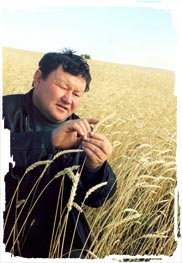 A Kazakh farmer wins by adopting CIMMYT-led technology.
A Kazakh farmer wins by adopting CIMMYT-led technology.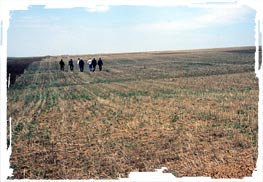
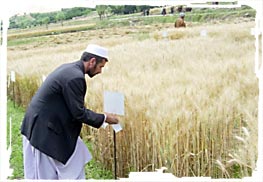
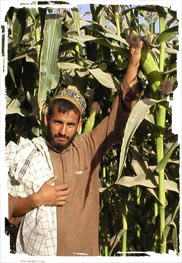 An important component of a current ACIAR-funded project (“Wheat and Maize Productivity Improvement in Afghanistan”) has included collaborative work with farmers and non-government and international organizations to verify in farmers’ fields the performance and acceptability of improved wheat and maize varieties. For wheat, the project uses two approaches:
An important component of a current ACIAR-funded project (“Wheat and Maize Productivity Improvement in Afghanistan”) has included collaborative work with farmers and non-government and international organizations to verify in farmers’ fields the performance and acceptability of improved wheat and maize varieties. For wheat, the project uses two approaches: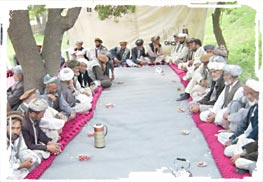
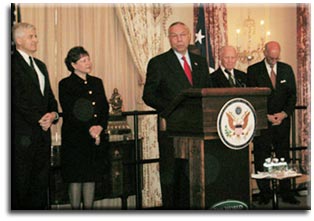 US Secretary of State Colin Powell paid tribute to Iowa and in particular to one man, known as the father of the Green Revolution, who was born there 90 years ago.
US Secretary of State Colin Powell paid tribute to Iowa and in particular to one man, known as the father of the Green Revolution, who was born there 90 years ago.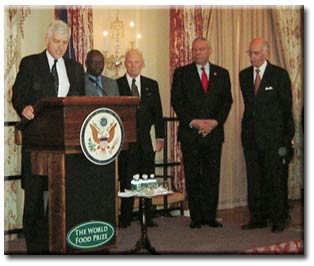
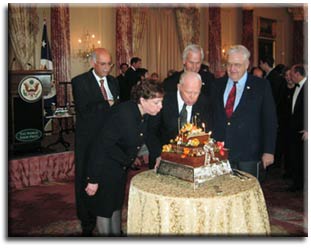
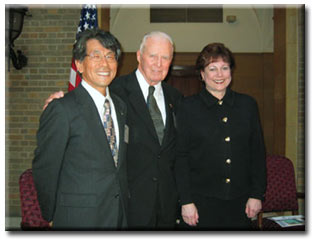
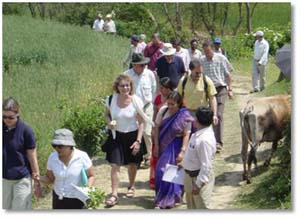 On the first day of the field visits, about 200 farmers from nearby villages greeted the delegation and expressed appreciation for new practices that were helping them to diversity agricultural production and conserve resources such as water and soil. The delegation was welcomed in Kapriwas, Gurgaon by senior officials of the
On the first day of the field visits, about 200 farmers from nearby villages greeted the delegation and expressed appreciation for new practices that were helping them to diversity agricultural production and conserve resources such as water and soil. The delegation was welcomed in Kapriwas, Gurgaon by senior officials of the 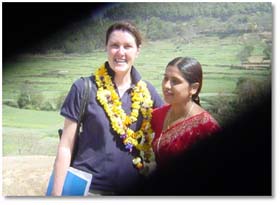 CIMMYT’s Board and staff are grateful to P.P. Manandhar, Nepal’s Secretary of Agriculture, and officials at the Ministry of Agriculture and Cooperatives for their constant support for CIMMYT’s South Asia Regional Office, and to NARC Executive Director R.P. Sapkota and his colleagues for support and field visits. They are also most grateful to ICAR Director General Mangla Rai, Deputy Director of Crops and Horticulture G. Kalloo, and the many representatives of experiment stations, colleges, and universities in India who made the visit a success. The opportunity to meet and visit the field with representatives of DFID, FAO, the Japan International Cooperation Agency, SDC, USAID, and the World Bank, among others, was also greatly appreciated.
CIMMYT’s Board and staff are grateful to P.P. Manandhar, Nepal’s Secretary of Agriculture, and officials at the Ministry of Agriculture and Cooperatives for their constant support for CIMMYT’s South Asia Regional Office, and to NARC Executive Director R.P. Sapkota and his colleagues for support and field visits. They are also most grateful to ICAR Director General Mangla Rai, Deputy Director of Crops and Horticulture G. Kalloo, and the many representatives of experiment stations, colleges, and universities in India who made the visit a success. The opportunity to meet and visit the field with representatives of DFID, FAO, the Japan International Cooperation Agency, SDC, USAID, and the World Bank, among others, was also greatly appreciated. After decades of stability, world food prices jumped more than 80% in 2008. Recent good harvests have brought prices down, but not to previous, historically-low levels, and most economists expect food costs to remain at much higher levels than before. At any moment catastrophic events like a drought or major crop disease outbreak could shock fragile grain markets and quickly send values skyrocketing anew.
After decades of stability, world food prices jumped more than 80% in 2008. Recent good harvests have brought prices down, but not to previous, historically-low levels, and most economists expect food costs to remain at much higher levels than before. At any moment catastrophic events like a drought or major crop disease outbreak could shock fragile grain markets and quickly send values skyrocketing anew.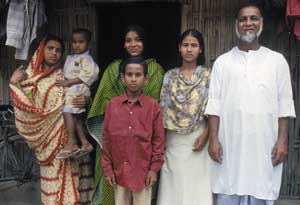 Work by CIMMYT with researchers, extension workers, policymakers, and farmers in Bangladesh for nearly four decades has helped establish wheat and maize among the country’s major cereal crops, made farming systems more productive and sustainable, improved food security and livelihoods, and won ringing praise from national decision makers in agriculture, according to a recent report published by CIMMYT.
Work by CIMMYT with researchers, extension workers, policymakers, and farmers in Bangladesh for nearly four decades has helped establish wheat and maize among the country’s major cereal crops, made farming systems more productive and sustainable, improved food security and livelihoods, and won ringing praise from national decision makers in agriculture, according to a recent report published by CIMMYT.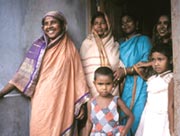

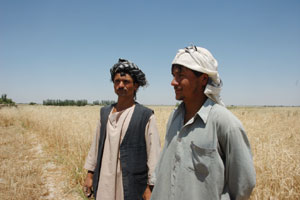 Faizal Ahmad and his brother Hayatt Mohammad are sharecroppers on this 8 hectare parcel of land. They pay the landowner a share and the crew that is harvesting gets a share, and with what is left, they try to feed their families, maybe sell a little.
Faizal Ahmad and his brother Hayatt Mohammad are sharecroppers on this 8 hectare parcel of land. They pay the landowner a share and the crew that is harvesting gets a share, and with what is left, they try to feed their families, maybe sell a little.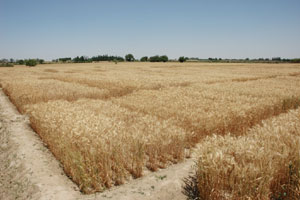 At least three more varieties developed from materials originally from CIMMYT (some via the winter wheat breeding program in Turkey) are in the new varietal release pipeline that Afghanistan has implemented. They have already demonstrated in farmers’ fields that they are well-suited to local conditions and can provide more wheat per hectare than farmers currently harvest with yields in on-farm trials of almost 5 tons per hectare, double what most farmers get. These wheats can be seen in trials at the Dehdadi Research Farm near Mazur, almost within sight of the sharecropping brothers.
At least three more varieties developed from materials originally from CIMMYT (some via the winter wheat breeding program in Turkey) are in the new varietal release pipeline that Afghanistan has implemented. They have already demonstrated in farmers’ fields that they are well-suited to local conditions and can provide more wheat per hectare than farmers currently harvest with yields in on-farm trials of almost 5 tons per hectare, double what most farmers get. These wheats can be seen in trials at the Dehdadi Research Farm near Mazur, almost within sight of the sharecropping brothers. A USAID-funded study by Williams College economist Douglas Gollin shows that modern maize and wheat varieties not only increase maximum yields in developing countries, but add hundreds of millions of dollars each year to farmers’ incomes by guaranteeing more reliable yields than traditional varieties.
A USAID-funded study by Williams College economist Douglas Gollin shows that modern maize and wheat varieties not only increase maximum yields in developing countries, but add hundreds of millions of dollars each year to farmers’ incomes by guaranteeing more reliable yields than traditional varieties. Farmer Juan Castillejos Castro of the village Dolores, Jaltenango, state of Chiapas, in southeastern Mexico, leaned forward in the humid, mid-morning heat and pondered the question: had household nutrition improved in the last 10 years? “From the mid-1970s to the mid-1980s, even I was malnourished to the point I couldn’t work,” he says. “Now things have gotten better, and the credits have helped a lot.”
Farmer Juan Castillejos Castro of the village Dolores, Jaltenango, state of Chiapas, in southeastern Mexico, leaned forward in the humid, mid-morning heat and pondered the question: had household nutrition improved in the last 10 years? “From the mid-1970s to the mid-1980s, even I was malnourished to the point I couldn’t work,” he says. “Now things have gotten better, and the credits have helped a lot.”
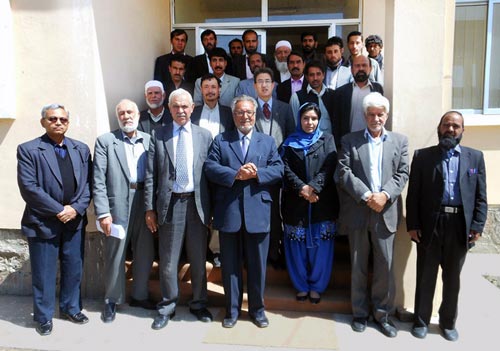 CIMMYT, with support from the Australian Centre for International Agricultural Research (ACIAR), has been working on maize in Afghanistan for more than ten years, and has contributed to the release—led by the Agricultural Research Institute of Afghanistan (ARIA)—of four maize varieties. Historically, the national research and seed systems have not been as proactive for maize as they have for wheat. However, recognizing that maize can be an effective contributor to overall food production, the recent past has seen efforts to give maize its due importance as a food crop in Afghanistan. To this end, the first ARIA-CIMMYT maize workshop was held at the ARIA conference hall in Kabul on 30 April and 01 May 2012, with the aims of further systematizing maize research in the country and coordinating the efforts of stakeholders.
CIMMYT, with support from the Australian Centre for International Agricultural Research (ACIAR), has been working on maize in Afghanistan for more than ten years, and has contributed to the release—led by the Agricultural Research Institute of Afghanistan (ARIA)—of four maize varieties. Historically, the national research and seed systems have not been as proactive for maize as they have for wheat. However, recognizing that maize can be an effective contributor to overall food production, the recent past has seen efforts to give maize its due importance as a food crop in Afghanistan. To this end, the first ARIA-CIMMYT maize workshop was held at the ARIA conference hall in Kabul on 30 April and 01 May 2012, with the aims of further systematizing maize research in the country and coordinating the efforts of stakeholders. A training course was held at the Agricultural Research Trust (ART), in Harare, Zimbabwe during 12-15 March 2012. Organized by CIMMYT-Zimbabwe, the course aimed to improve the skills and knowledge of maize technicians regarding implementing on-station and on-farm trials, seed production, and the use of secondary traits in selecting superior genotypes under low N and drought trials.
A training course was held at the Agricultural Research Trust (ART), in Harare, Zimbabwe during 12-15 March 2012. Organized by CIMMYT-Zimbabwe, the course aimed to improve the skills and knowledge of maize technicians regarding implementing on-station and on-farm trials, seed production, and the use of secondary traits in selecting superior genotypes under low N and drought trials.